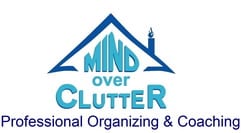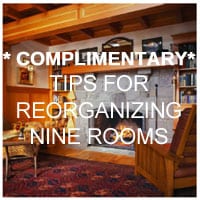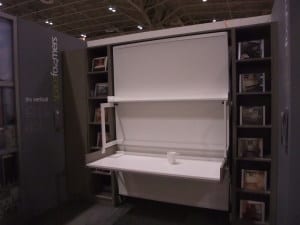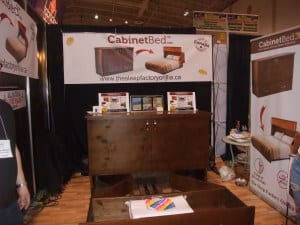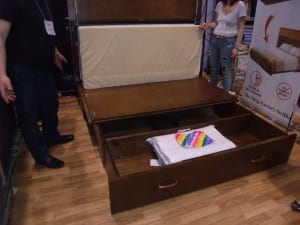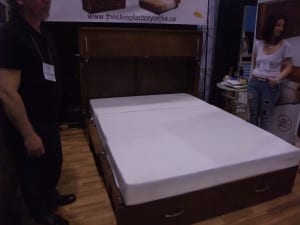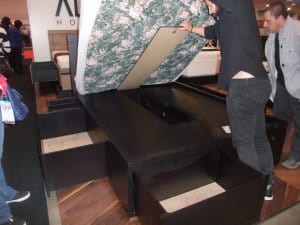Latest Blog Posts
I recently attended the National Home Show in Toronto, Canada. As an organizer, I was looking for new and exciting ideas for organizing your home. Many people are choosing to live in small spaces. If your home is small then everything needs to have more than one function.
There were many different companies with beds that folded into the wall, beds that are desks until they were moved into a position to be a bed,
and a bed in a cabinet. The bed also has a drawer for storing bedding and other items.
Depending on the shape of your space one type of unit may be better than another one. The selling feature of the bed in a cabinet is it doesn’t need to be attached to the wall and seemed to be the design that it could be easily moved around within a home or to a new home.
Buying a bed that allows you to have great storage options can solve some problems. This bed has drawers for storage, on the end and the side as well as under the mattress.
What is the most versatile piece of furniture you have seen or purchased?
 Julie Stobbe is a Trained Professional Organizer and Lifestyle Organizing Coach who brings happiness to homes and organization to offices, virtually using Zoom. She has been working with clients since 2006 to provide customized organizing solutions to suit their individual needs and situation. She uses her love of teaching to reduce clutter, in your home, office, mind and time. She guides and supports you to be accountable for your time, to complete projects and reach your goals. If you’re in a difficult transition Julie can coach you to break-free of emotional clutter constraining you from living life on your terms. Online courses are available to help instruct, coach and support your organizing projects. Get started by downloading Tips for Reorganizing 9 Rooms.
Julie Stobbe is a Trained Professional Organizer and Lifestyle Organizing Coach who brings happiness to homes and organization to offices, virtually using Zoom. She has been working with clients since 2006 to provide customized organizing solutions to suit their individual needs and situation. She uses her love of teaching to reduce clutter, in your home, office, mind and time. She guides and supports you to be accountable for your time, to complete projects and reach your goals. If you’re in a difficult transition Julie can coach you to break-free of emotional clutter constraining you from living life on your terms. Online courses are available to help instruct, coach and support your organizing projects. Get started by downloading Tips for Reorganizing 9 Rooms.
Contact her at julie@mindoverclutter.ca
Click here to learn more about her online course Create an Organized Home.
Twitter – Facebook – Facebook group Organizing Mind and Space
I participate in Professional Organizers Blog Carnival along with many other organizers. Janet Barclay has developed this site to help people get a lot of ideas on many organizing topics. This month the blog site is about everything related to the holiday season and gift giving. I hope you enjoy reading it. Read my submission on Clutter free Gift giving. https://organizedassistant.com/holiday-gift-giving-pobc/
For children of parents with hoarding disorder, the mess remains after their parents pass away.
Newsweek By Hannah R Buchdahl Jan 26, 2011
Greg Martin wasn’t sure what to expect when his mother died last May, forcing him to return to his childhood home for the first time in nearly 18 years. The house, located on a pleasant block in San Diego, had always been cluttered, but now it was virtually uninhabitable. “There were piles as tall as me, six feet or so,” Greg said. “Where there used to be floor, there were trails—a foot and a half high, so you’d be walking on stuff.” Greg was forced to navigate through piles of magazines, papers, and books, plastic bags filled with thrift-store purchases, expired medicine bottles and literally tons of clothes. The only “living space” was a small pocket by the front door, where his mother, a colorful and fiercely independent woman, had collapsed shortly before her death at the age of 83. Greg, who has taken a leave of absence from his job, expected that cleaning out the house would take six months. It’s now been eight—and counting.
It’s a scenario that’s all too familiar to children of hoarders, who are burdened with far more than funeral arrangements, probate, and grief. They must also deal with the overwhelming piles of stuff that a parent with hoarding disorder accumulated over the years—in apartments, in houses, in storage facilities, and in garages. The items themselves may vary, but for many children of parents with hoarding disorder, the result is the same: the unwanted inheritance of a whole lot of nothing.
Greg Martin’s mother lived in this home until her death last year. (milbetweenus.blogspot.com)
The inclination to hoard typically begins in the teenage years, but experts say it can also be triggered—or made worse—by brain damage, a traumatic life event, or depression. As the people with hoarding disorder age, the piles grow, gradually eclipsing everything else in their lives.
“I’m dreading the day when the house needs to be cleaned out, more than I dread the day that they leave us,” laments Teresa C. of Winnipeg, Canada. Teresa, like several others interviewed for this story, did not want to give her last name because the hoarding is a source of tension in her family. For Teresa, inheriting her ageing parents’ hoard is a worry for the future.
Hoarding is an extremely complicated mental disorder that generally involves the acquisition of too many items, difficulty getting rid of items, and problems with organization and prioritization. Few statistics exist related to hoarding, because people with hoarding disorder rarely seek or accept treatment. But shows like Hoarders have certainly raised awareness and triggered a tidal wave of anecdotal evidence to suggest the illness, often associated with obsessive compulsive disorder, affects millions—either directly or indirectly. Support groups and message boards are flooded with stories about the once-secret life of a person with hoarding disorder and their families, and the constant battles to get the person to understand the impact their illness is having on their loved ones. That impact doesn’t end with their passing.
“Nine times out of 10, it’s not the person with hoarding disorder who suffers; it’s whoever comes after them to clean up,” says a very frustrated Bill L. of Colorado, who’s been working to clean his mother’s home, located in a different state, for almost five years. (She suffered a stroke and has since moved into assisted living.) It took a dozen people, and eight Dumpsters, to clear out the first floor. Still to go: the second floor, a large attic, a basement, a garage, and a storage locker that Bill says should be easy, but may not be.
Often, people with hoarding disorder are the only ones who know or understand their system of “organization,” keeping stock certificates amid expired receipts or diamonds amid a pile of junk jewelry. For survivors, the stress and strain related to the search itself may simply outweigh the potential of finding any objects with financial or sentimental value. Bill plans to return to his mother’s house soon with a professional cleanout crew. “That will mean forgetting about recovering anything of value,” he says, “including possible family heirlooms. If we tried to continue sifting the hoard, we’d still be at it 10 years later [and] we’d be jobless, homeless, and insane.”
Cory Chalmers, owner of California-based Steri-Clean, which provides help finding hoarding-remediation specialists around the globe, estimates a typical clean-up can range from $5,000 to $20,000 and beyond depending on the severity of the hoard, conditions inside the home, and regulations relating to the disposal of electronics and hazardous materials. His crews occasionally recover items of value that may help offset the cost of the cleanup. But more often than not, it’s a simple, yet massive case of quantity over quality. “Most of the elderly people with hoarding disorder we work with all say the same thing: they’re saving this because it all has use, ‘I want to give this to my son, and this to my daughter, and this to my grandchild. [But] no one wants that crap,” he says, not without sympathy. “What they see as this big investment to pass on is really a big stress on families and not even worth it. A lot of them don’t want it. They’d rather just walk away.”
Share where you found your best information on hoarding disorder.


Contact her at julie@mindoverclutter.ca
Twitter – Facebook – Facebook group Organizing Mind and Space
Click here to learn more about working with a Professional Organizer.
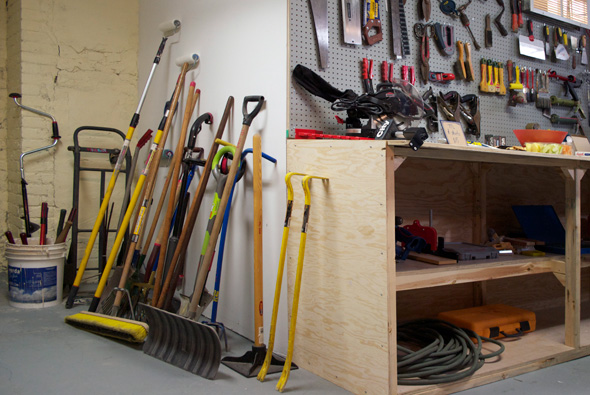

Get your tools here, and donate your tools here
We have toy lending libraries. kitchen lending libraries and, now a tool lending library. People can donate tools to the library that they no longer use. It gives people access to tools that they might not otherwise be able to afford to purchase or don’t need to buy because they use these tools infrequently. Read about Toronto’s first tool lending library.
Share places that you have found to donate your tools.




Contact her at julie@mindoverclutter.ca
Click here to learn more about her online course Create an Organized Home.
Twitter – Facebook – Facebook group Organizing Mind and Space
Here are some tips from Crime Stoppers published May 13, 2013
An estimated 10 million people each year become victims of identity theft. There are things each of us can do to help prevent becoming one.
- Try not to leave mail in your mailbox for long.
- When sending mail out that contains any kind of account information, it’s best to drop it off directly into a postal box rather than leave it in your mailbox for your carrier.
- Pay attention to when your regular bills or account statements are due to arrive and follow up if they are late. Thieves have been known to submit “change of address” forms to divert mailings. Your account information, including utilities, can then be used to set up phony accounts in your name or run up charges.
- Virtually any document containing more personal identifiers than your name and address can be used by an identity thief and should be shredded. It can be stolen from your purse or wallet, your trash or even your home.
- Be mindful of where you place bank and credit card statements within your residence if you employ outside help or are having work done inside.
- When you are required or asked by a company to provide your Social Insurance number, don’t be afraid to ask why they need it and what their policy is to protect it. Businesses are required by law to properly dispose of your personal information.
For more information, visit MichianaCrimeStoppers.com




Contact her at julie@mindoverclutter.ca
Click here to learn more about her online course Create an Organized Home.
Twitter – Facebook – Facebook group Organizing Mind and Space
- « Previous
- 1
- …
- 22
- 23
- 24
